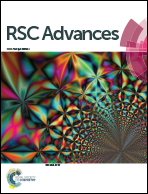CO2 adsorption on crab shell derived activated carbons: contribution of micropores and nitrogen-containing groups†
Abstract
Nitrogen-doped activated carbons with high and selective CO2 adsorption are attractive for carbon capture, but the contribution of nitrogen-containing groups to CO2 adsorption has not been clearly elucidated. In this study, crab shells are used as a carbon precursor for the preparation of effective N-containing activated carbons for CO2 adsorption. The activated carbon prepared at a KOH/C mass ratio of 1.5 and activation temperature of 650 °C has the highest CO2 adsorption of 1.57 mmol g−1 at 0.15 bar & 25 °C and 4.37 mmol g−1 at 1 bar & 25 °C. The activated carbon also exhibits better adsorption selectivity for CO2 than conventional activated carbons, and the content of pyrrolic-N in the activated carbons shows a positive relationship with CO2/N2 selectivity. The activated carbons prepared under different activation conditions contain 5.1–8.5% nitrogen in the form of pyridinic-N, pyrrolic-N, quaternary nitrogen, and pyridinic-N-oxide, accounting for at least 0.9–78.2% contribution to CO2 adsorption at 25 °C & 1 bar. About 45.1–47.3% of doped nitrogen is verified to be pyrrolic-N via X-ray photoelectron spectroscopy (XPS) analysis, which is effective for CO2 adsorption. However, the effective micropores are mainly responsible for CO2 adsorption on the well-developed activated carbons via a micropore filling mechanism.


 Please wait while we load your content...
Please wait while we load your content...